Buying A New Car? Should You Trade Your Existing Car In Or Try To Sell It Yourself?
Are you buying a new car? Getting a new car is exciting, but most people are then faced with the challenge of what to do with their existing vehicle. Should you try and sell your old car yourself or is it best to trade in your car at the dealership?
Generally, if you want to get more money from your old car, you’re likely to get more if you sell the car yourself. The main reason for this is that dealerships need to factor in enough money to clean up and do any repairs to your car so they can resell it and make a profit. (And if your car is an older model or one that’s not in demand, you may even get less money.) However, trading in your old car at the dealership is more convenient than going through the aggravation of trying to sell your car privately.
For the most part, trading in your old car at the dealership is hassle-free, but selling your car privately takes a lot of time and effort — you have to advertise your car, answer emails and phone calls, take people out for test drives, negotiate the price, transfer the title, etc. When you trade in your car with the dealership, it’s all done quickly.
There are some other benefits to trading in your car at a dealership:
- Get a better price on your new car: The car dealership will want your business! If your trade-in is paid off, you have some bargaining power that you can use because you can put that cash towards your new car.
- No complaints: If you sell your car privately, you run the risk of that person coming back to you later complaining about some problem they may have with the car they purchased from you. You won’t have to worry about those types of complaints from a dealership.
- Nicks, scratches and repairs? No problem: Most car dealers won’t worry too much if there are some scratches or minor service repairs that need to be made. They will take care of those repairs before they sell it.
When trading in your vehicle, keep the new car negotiations and your trade-in negotiations separate. The money you receive from your trade-in should be written as a credit against the purchase price of your new car. In some states, you pay sales tax on the difference between the new car and the trade-in. This means that you could be paying less sales tax on your new car! (Check with your dealership to see if this tax break applies in your state.)
Also, if you’re planning to trade your car in, try to do it at the end of the month when a car dealer will typically be more eager to bargain with you.
Tips When You Sell Your Car Privately
If you decide to sell your car on your own, get ready for a little work. (Selling a car is not for the faint of heart!) There is a lot involved with selling your vehicle: getting it ready to sell, marketing/advertising, fielding calls and emails, scheduling viewings and test drives, negotiating the price, transferring the title/paperwork, etc.

Here are some tips if you want to sell your car privately:
Get your car ready for the sale: Make sure you make any repairs and fix any scratches and dents that you think will increase the value of your car (without breaking the bank.) These types of improvements will typically increase the price you will get for the car. Also, clean out the interior of your car. Vacuum the interior, wipe down the dashboard and doors, get rid of the wrappers and pop cans, take out anything personal and don’t forget to empty the trunk! Check the fluids (oil, brake and windshield) and get your car washed, waxed and the tires detailed.
Gather the paperwork. Make sure you have the vehicle’s title, warranty information and any inspection or maintenance paperwork handy.
Determine your price. Before you can list your car for sale, you need to determine how much money you can expect to receive for your vehicle. The best way to come up with your asking price is to check with a local car dealership or go online and check out resources like KBB.com or Edmunds.com.
Take pictures of your car. Take LOTS of pictures of your car – from a variety of angles. Be sure you take photos of the interior, exterior, the trunk, dashboard, engine, steering wheel, floors, seats, etc. The more you show, the better. (You don’t want people to think that you have anything to hide.)
Write the ad. When you create the ad, be very specific with the details of your vehicle – what it looks like, the features it has and why they’re cool, how it handles (especially in inclement weather), etc. The more details the better. Don’t just use words like “fully-loaded” or “well-equipped” – those catch-phrases don’t mean much. Also, be honest about the things that are wrong with the vehicle, too. (No car is perfect.) If there’s a dent, show a picture of it. If a brake line needs to be replaced, put that in the ad. Full disclosure is the right thing the do – and it will save you from potential hassles later. When putting your contact information in the ad, use a generic email address instead of a company email address.
Advertise. The best way to sell your car is by placing online ads. Sites like autotrader.com, Craig’s List, cars.com and even Facebook Marketplace are all great places to show off your car’s listing. Put a “For Sale” sign in the car when it’s parked on the street or when you’re driving around, ask your friends and family to share pictures on social media, let your mechanic know that it’s for sale, etc. Promote. Promote. Promote.
Showings and test drives. When people come to look at the car, for safety reasons it’s best to meet people in a public location instead of at your home. Be on your guard. The test drive is when thieves can try to steal your vehicle. Make sure you get the person’s name, address and their Driver’s License. Before you let anyone test drive the car, make sure you contact your insurance company to make sure that the driver would be covered and don’t let them drive the car alone.
Negotiation. When you have an interested buyer, make sure that you start with a price that is a little higher than what you are willing to accept so you can negotiate down. Remember that you’re in charge of the final asking price, so don’t let anyone bully you into selling your car at a price that you’re not comfortable with. If you don’t feel good with now the negotiations are going, end them.
The sale! So you got an offer on your car. Congratulations! Before you sign over the title, make sure that you get paid with cash or a cashier’s check. Do not accept a personal check or an escrow service. Also, never give out your social security number or bank information to the buyer.
Whether you choose to sell your car privately or through your dealership, hopefully these tips will help make the process easier for you. Good luck!
If you’re ready to get your new car, come visit us at Neil Huffman Mazda. We’ll be happy to show you some of our new Mazda vehicles and talk with you about your trade-in!





